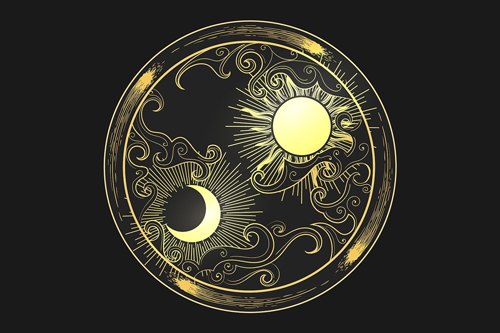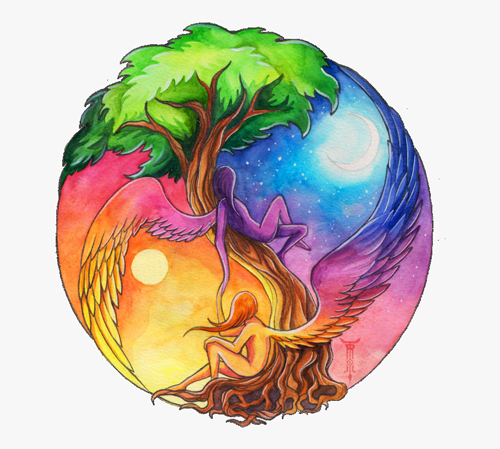Tagalogs are believed to be the first settlers of Manila when the Spaniards declared Manila as the colony capital in the 16th century. Tagalog came from the word “taga-ilog” which means “people from the river” (literally living along the river).
Among the Tagalogs, the myth of the sun and the moon has survived in the form of a fairy tale, confirming Henry Otley Beyer’s observation that “among the Christianized peoples of the plains, the myths are preserved chiefly as folk tales” (Beyer 1913:85). Although the sisters in the first tale were named Araw and Buwan, like the Pangasinan Agueo and Bulan, they themselves did not give off light. It was their diamonds, thrown into the sky by the angels, that shone there and were later called Araw and Buwan.
The other Tagalog version seems to be older and preserves the identities of Araw and Buan as deities who ruled day and night, respectively. Buan however was a usurper, shining also during the last part of the day and sometimes during the morning. A quarrel ensued despite the efforts of Lihangin, the god of the wind, to mediate. Buan was badly hit and parts of her body were scattered and became the stars. Since that time, the Moon has not been as bright as before. The tale shares similarities to the Kapampangan story of Apolaki and Mayari.

Why the Sun Shines More Brightly Than the Moon
Long, long ago there lived a fairy with two very beautiful daughters. Araw, the older daughter, was very amiable, and had a kindly disposition; but Buwan, unlike her sister, was dishonest, cruel, and harsh. She was always finding fault with Araw. One night, when the fairy came home from her nocturnal rambles and saw Buwan badly maltreating her elder sister, she asked God for help against her unruly daughter.
Before this time God has prepared very valuable gifts for the two sisters. These gifts were two enormous diamonds that could light the whole universe. When God heard the prayer of the fairy, he descended to earth disguised as a beggar. On learning for himself how bad-tempered Buwan was, and how sweet and kind- hearted Araw was, God gave the older sister her diamond as a reward. Buwan was greatly angered by this favoritism on the part of the Almighty, so she went to the heavenly kingdom and stole one of God’s diamonds. Then she returned to earth with the precious stone, but there she found that her jewel was not as brilliant as Araw’s.
When God went back to heaven and learned what Buwan had done, he sent two angels to punish her. But the angels abused their commission: they seized both sisters and hurled them into the sea. Then they threw the two stones upward into the sky and there they stuck. But Araw’s diamond was bigger and brighter than the one Buwan stole. Thereafter the bigger jewel was called Araw (“day” or sun) and the smaller one, Buwan (“moon”).

Note: Very similar stories appear throughout Philippine Mythologies about why the sun is brighter than the moon. This motif is more famously known as the Kapampangan myth of Apolaki and Mayari. F. Landa Jocano later documented Mayari as a Tagalog deity (daughter of Bathala). I haven’t seen the fieldnotes, so I am unsure where the Tagalog tale came from. Maximo Ramos presented the tale in “Philippine Myths, Legends and Folktales.” Some may have assumed it is Tagalog, because of Bathala being presented as creator of the world and the father of Mayari. In most Kapampangan myth Mangechay is the supreme creator.
Kapampangans once occupied a vast stretch of land that extended from Tondo to the rest of Central Luzon. Huge chunks of territories were carved out of Pampanga so as to create the provinces of Bulacan, Bataan, Nueva Ecija, Aurora and Tarlac. As a result, Kapampangans now populate a region that extends beyond the political boundaries of the small province of Pampanga.
It is no wonder that Tagalog and Kapampangan myths mirror each other.
The Origin of the Stars
Hundreds of years ago some people said there were no stars. The sun was a mighty god. He was the ruler of the day. Buan, the moon, was a rival god of the sun and desired to rule both day and night. Lihangin, god of the wind, was a friend of the sun and the moon. One day he went to visit Araw, god of the sun, to warm himself. When they were sitting together, Araw told Lihangin* that he had a bad feeling toward Buan. He said that he noticed him showing during the day. This meant that he desired to occupy a part of Araw’s kingdom. Lihangin wanted them to be good friends. He told Buan not to occupy a part of Araw’s kingdom. He said that Araw was just, so Buan must act the same. The moon did not pay attention to his advice. He continued to shine during the latter part of the day and sometimes during the morning. Araw could not bear it. He told Buan not to do it any more. Buan insisted. They had a quarrel. Buan was badly hit. Parts of his body were scattered around and these became the stars. The moon did not have its former light. Such was the origin of the stars.
*Note: In this last tale, Eugenio notes the story is from “Tagalog Folktales,” Dean Fansler collection, 1922. She went on to say, ” I heard this story in the town of San Miguel, Bulacan—Miguel Manuson.” The deity Lihangin is known as the Visayan deity of the wind, and was not mentioned by name in Fansler’s work, so this may have been a modern documentation by Damiana Eugenio herself. Without seeing the fieldnotes, this is possibly the result of transient workers and the constant movement of people throughout the archipelago. It is also interesting to note that Eugenio documented a Tagalog tale where the Visayan deity Sidapa appears as the god of war (Why the Cock Crows at Dawn). This is what is so beautiful about Philippine Mythologies. They have always been evolving. We have a tendency to try to lock beliefs into the moment they were first documented. Lihangin was documented as a Visayan deity by John Maurice Miller in 1904 (Philippine Folklore Stories). Had he not documented that story, Lihangin might be known today as a Tagalog deity.
SOURCES:
Origin Myths from Philippine Mountain Peoples, Henry Otley Beyer, From the Division of Ethnology, Bureau of Science, Manila, P. I. 1913
Philippine Folk Literature: The Myths, Damiana Eugenio, UP Press, 2001
Jordan Clark is a Canadian born descendant of Scottish immigrants living on the homelands of the Lekwungen speaking peoples. His interest in Philippine myth and folklore began in 2004. Finding it difficult to track down resources on the topic, he founded The Aswang Project in 2006. Shortly after, he embarked on a 5 year journey, along with producing partner Cheryl Anne del Rosario, to make the 2011 feature length documentary THE ASWANG PHENOMENON – an exploration of the aswang myth and its effects on Philippine society. In 2015 he directed “The Creatures of Philippine Mythology” web-series, which features 3 folkloric beings from the Philippines – the TIKBALANG, KAPRE and BAKUNAWA. Episodes are available to watch on YouTube. Jordan recently oversaw the editing for the English language release of Ferdinand Blumentritt’s DICCIONARIO MITOLÓGICO DE FILIPINAS (Dictionary of Philippine Mythology) and is working on two more releases with fellow creators scheduled for release later this year. When his nose isn’t in a book, he spends time with his amazing Filipina wife of 20 years and their smart and wonderful teenaged daughter.


